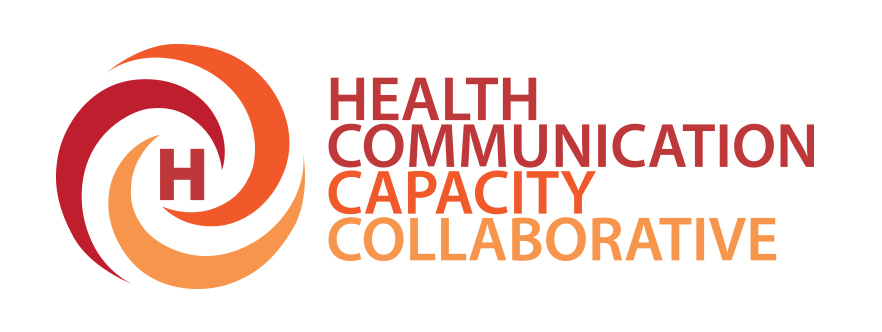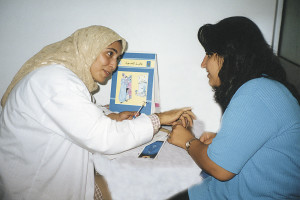About this I-Kit
This I-Kit introduces users to the building blocks for a social and behavior change communication (SBCC) strategy for breastfeeding. It links the SBCC strategy development to faith-based organizations (FBOs) assets such as religious leaders and religious texts. It includes basic information about breastfeeding and the role of FBOs, religious leaders and faith communications in improving child survival.
Each step includes activities to help users develop all of the elements of a well-planned SBCC strategy. It may be used as a starting point for developing an SBCC strategy and generating ideas and approaches for new programs. They can also use it as a resource for revising and refocusing an existing strategy, program or set of activities.
Who can use this I-Kit?
A range of audiences can use the Guide and I-Kit. It is aimed primarily at faith-based organizations whose staff wants to use SBCC to increase the use of breastfeeding to improve child health. Staff might be:
- Program managers, designers and implementers who work (or want to work) in child survival or maternal, newborn and child health (MNCH)
- Program managers, designers and implementers who want to incorporate SBCC in their work
And they might work in:
- FBOs interested in child survival/MNCH
- Child survival/MNCH organizations
- SBCC-focused organizations
- Ministries of Health, Child Welfare, Women, Social Services, and others
Programs should use the Kit as an adaptable tool to provide a quick-start foundation create SBCC strategies tailored to their context. The Kit uses an evidence-based approach to SBCC strategy development and can inspire local and national SBCC strategies. It is intended for users in low-resource settings.
What does this I-Kit contain?
The Kit may be used as a starting point for developing an SBCC strategy and generating ideas and approaches for new programs, or it may be used as a resource for revising and refocusing an existing strategy, program, or set of activities.
This Program Guide is the foundation of the I-Kit. The Guide introduces users to the building blocks for developing an SBCC strategy for breastfeeding.
- Introduction provides context for developing a breastfeeding SBCC strategy. It includes basic information about breastfeeding and the role of FBOs, religious leaders and faith communities in improving child survival.
- I-KIT: Supporting Breastfeeding Interventions for Faith-Based Organizations explains concepts and steps in developing an SBCC strategy and provides an example of the completed steps using global-level data.
- Use this to complete SBCC templates in Appendix A.
- Appendix B has additional information on breastfeeding basics
- Appendix C provides sample questions for conducting a situational analysis
- Appendix D provides additional sample messages for promoting optimal breastfeeding
Each step of a six-step process includes activities to help users develop all of the elements of a well-planned SBCC strategy. The six steps and the estimated time for completing them are outlined below. The estimated timeframes will help you plan your strategy development.
| Step | Estimated Timeframe |
| Step 1. Define a Vision | ½ day |
| Step 2. Analyze the Situation | 2 weeks |
| Step 3. Analyze the Audience | 3 weeks |
| Step 4. Define a Message Strategy | 2 weeks |
| Step 5. Determine Activities and Interventions | 2 weeks |
| Step 6. Plan for Monitoring and Evaluation | 2 weeks |
What are best practices for using this I-Kit?
Program managers should plan for an estimated 11 weeks to complete the six-step process from beginning to end, longer if formative research is conducted. It is highly recommended that these steps be completed by a team of people with various technical strengths, including knowledge of breastfeeding practices, knowledge of local cultural and faith practices in different regions of the country where you will work, and experience with monitoring and evaluation. These could consist of program managers, nurses and/or midwives, social and behavior change communication professionals, monitoring and evaluation professionals, religious leaders, and others. It is also recommended that teams develop a schedule of when to meet each week and assign different roles and responsibilities to the team members for completing the various tasks.
Below is an illustrative schedule for completing the strategy within the 11-week timeframe.
Weeks 1-2
Vision & Situation Analysis
Read Introduction. Fill out Step 1. Vision Template from Appendix A
Fill out Step 2. Situation Analysis Templates from Appendix A
Weeks 3-5
Analyze the Audience
Fill out the templates in Step 3. Analyze the Audiences from Appendix A
Refer to Step 3
Weeks 6-7
Define a Message Strategy
Fill out the template in Step 4. Define a Message Strategy from Appendix A
Refer to Step 4
Weeks 8-9
Determine Activities and Interventions
Fill out the template in Step 5. Determine Activities and Interventions from Appendix A
Refer to Step 5
Weeks 10-11
Plan for Monitoring & Evaluation
Fill out the Step 6. Plan for Monitoring and Evaluation Template
Refer to Step 6
What do we mean by SBCC and an SBCC Strategy?
SBCC is the practice of using the most powerful and fundamental human interaction – communication – to positively influence knowledge, attitudes and social norms. SBCC capitalizes on opportunities for change and addresses obstacles to change to help people change behaviors. SBCC recognizes that, while individuals have choice and responsibility, social context also influences behaviors. The social context can include the family, the community, values, and the environment in which change must take place. Structural considerations also matter, such as whether facilities and policies support the change or are barriers to change. For example, if we want pregnant women to get antenatal care (ANC), we must:
- Get women to want antenatal care (ANC) and spend the time, energy and money needed to get it (Individual)
- Get male partners and other family members to support women’s seeking ANC services (Social)
- Make getting ANC the normal thing to do in that community – everybody does it, so everyone is expected to do it, and rarely does anyone seriously consider not doing it. (Social)
- Promote and provide ANC as part of workplace health programs. (Social and Structural)
- Advocate for having an ANC provider or facility within a reasonable walking distance for a pregnant woman or reachable with adequate transportation. (Structural)
- Advocate for policies that promote, enable and ensure adequate ANC staffing (including technical and interpersonal skills), equipment and supplies. (Structural)
What is the role of A Promise Renewed in Child Survival?
The Promise in A Promise Renewed refers to Millennium Development Goal (MDG) 4, the world’s promise to reduce under-five mortality by two-thirds between 1990 and 2015. A Promise Renewed is based on the idea that child survival is a shared responsibility. Globally, the number of child deaths has dropped from nearly 12 million in 1990 to 6.9 million in 2011. Many countries have greatly reduced their very high child death rates [1] . While this is great progress, most of these 6.9 million children die from causes that we have the power to prevent, and from diseases that we can treat. We can do better.In June 2012, more than 700 representatives from government, civil society and the private sector met to advance the Child Survival Call to Action. Evidence shows that most countries can make it so that fewer than 20 of every 1000 children born die before age five. To make this happen, governments and partners are uniting under the banner of A Promise Renewed to support joint action to reduce child deaths.
To help translate the Promise into action, partners in Religions for Action made “Ten Promises to Our Children”, focused on promoting, encouraging, and advocating for priority interventions and behaviors in health, nutrition, and other key areas related to child survival. The first promise on that list is to promote, encourage, and advocate for exclusive breastfeeding for the first six months of life.
Next: The Role of Religious Leaders and Faith Communities


